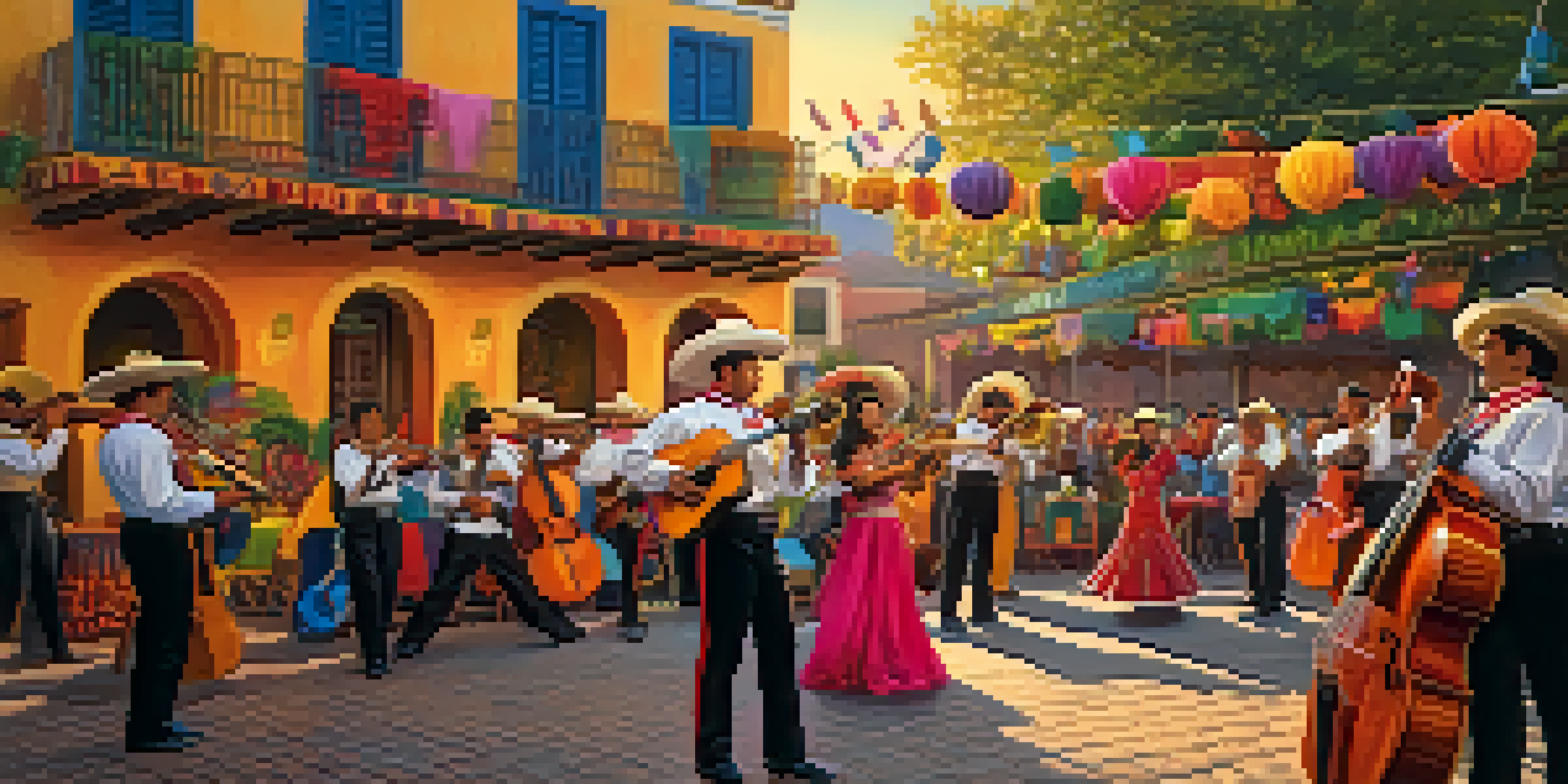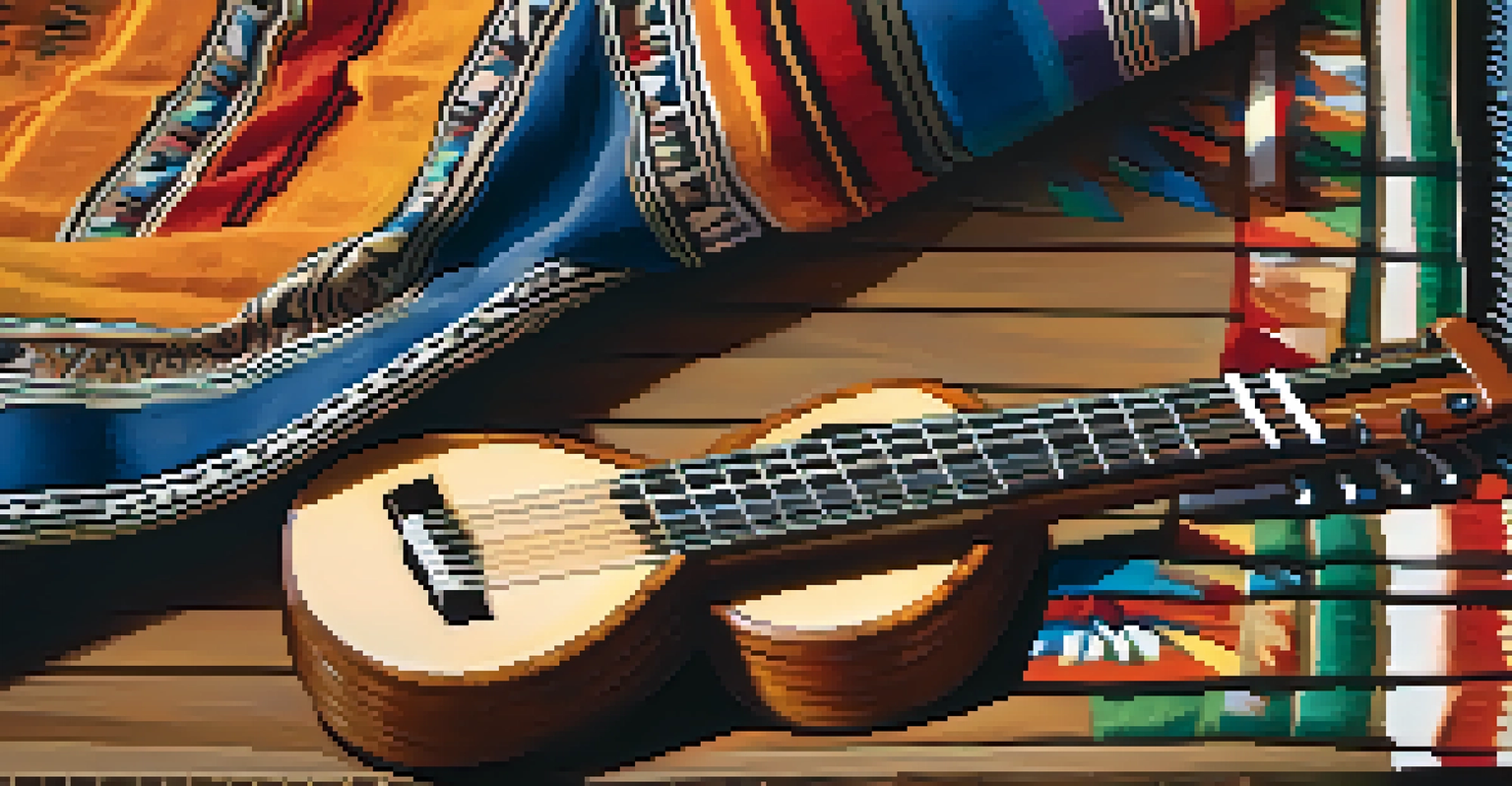Latin American Guitar Styles: A Cultural Exploration

The Heartbeat of Latin America: Guitar's Role in Culture
Guitar music is deeply woven into the cultural fabric of Latin America. It's not just an instrument; it’s a voice that echoes the histories, struggles, and joys of the people. From lively fiestas to solemn ceremonies, the guitar often takes center stage, illustrating the emotional landscape of the region.
Music is the shorthand of emotion.
Each country boasts its own unique styles, reflecting local traditions and influences. For instance, the vibrant sound of the charango in Bolivia showcases indigenous roots, while the flamenco guitar in Spain’s Andalusia has also left its mark on Latin American music. These variations highlight how the guitar serves as a bridge between cultures, expressing shared experiences.
As you explore the different styles, you'll find that the guitar is both a solo instrument and a key component in ensembles. It's the guitar's versatility that allows it to adapt, making it an essential part of genres like bossa nova, tango, and mariachi, further enriching the cultural tapestry of Latin America.
Flamenco: Passionate Guitar Traditions from Spain
Flamenco guitar, originating from the Andalusian region of Spain, has profoundly influenced Latin American music, especially in countries like Argentina. Characterized by its intricate fingerpicking and emotional intensity, flamenco embodies the spirit of its cultural roots. The guitar is often accompanied by singing and dancing, creating a powerful, immersive experience.

The guitar techniques used in flamenco, such as rasgueado and picado, are not just technical skills but expressions of passion and storytelling. Each strum and pluck conveys deep emotion, making the performer a vital storyteller. This interplay of music and movement is what captivates audiences and creates a lasting impression.
Guitar's Cultural Significance
The guitar serves as a vital expression of the diverse cultural identities and histories throughout Latin America.
As flamenco spread to Latin America, it adapted and evolved, merging with local sounds and styles. This fusion has given rise to various interpretations, enriching the musical landscape and showcasing the guitar’s adaptability. Flamenco’s influence is a testament to how cultural exchange can create something beautifully unique.
Bossa Nova: The Smooth Sounds of Brazil
Bossa nova emerged in Brazil in the late 1950s, blending samba rhythms with jazz influences to create a smooth, laid-back sound. The guitar plays a pivotal role in this genre, often featuring soft chord progressions and syncopated rhythms that invite listeners to relax and unwind. Iconic songs like 'Garota de Ipanema' showcase the guitar’s ability to evoke a sense of longing and nostalgia.
The guitar is a miniature orchestra in itself.
The bossa nova guitar style highlights the importance of harmony and melody, with musicians like João Gilberto setting the standard. His innovative use of fingerpicking techniques has inspired countless guitarists, making bossa nova a significant part of Latin American music. The ease and grace of the guitar in this genre reflect the Brazilian lifestyle, emphasizing leisure and beauty.
As bossa nova gained international popularity, it served as a cultural ambassador for Brazil. The genre’s smooth sounds and elegant rhythms have resonated worldwide, influencing musicians across genres. This illustrates how the guitar can transcend borders, connecting people through its universal language.
Tango: The Soulful Sounds of Argentina
Tango music is synonymous with Argentina and is characterized by its rich emotional depth and dramatic flair. The guitar, often accompanied by the bandoneón, plays a crucial role in conveying the passionate and melancholic themes of tango. Its rhythmic strumming and intricate melodies encapsulate the essence of the dance, drawing listeners into a world of romance and longing.
The guitar in tango is not merely an accompaniment but a lead instrument that expresses the narrative of the dance. Famous tango composers like Astor Piazzolla have elevated the guitar's role, blending traditional elements with modern influences. This evolution illustrates the guitar's ability to adapt while staying true to its roots.
Genres Showcase Guitar Versatility
From flamenco to bossa nova, the guitar adapts to various genres, illustrating its integral role in Latin American music.
As tango evolved from the streets of Buenos Aires to international stages, the guitar remained a vital element of its identity. The genre's global appeal showcases how the guitar can tell stories that resonate with people from all walks of life, fostering a deep emotional connection.
Mariachi: Celebrating Mexican Heritage through Guitar
Mariachi music is a vibrant representation of Mexican culture, and the guitar is at its core. Typically performed by a group of musicians, mariachi features violins, trumpets, and, of course, guitars that create a lively and festive atmosphere. This genre often accompanies celebrations and gatherings, embodying the spirit of community and joy.
The guitar in mariachi serves multiple functions, from providing rhythmic support to showcasing intricate solos. Musicians often employ techniques like strumming and fingerpicking to create a rich tapestry of sound that captures the audience's attention. The lively nature of mariachi music invites participation, encouraging people to dance and sing along.
As mariachi has gained popularity beyond Mexico, the guitar has become a symbol of Mexican identity. Its influence can be seen in various musical genres across the globe, demonstrating how the guitar can embody cultural pride and foster connections among diverse audiences.
The Charango: A Unique Voice of the Andes
The charango is a small Andean string instrument, traditionally made from the shell of an armadillo. With its high-pitched sound, the charango brings a distinct flavor to Latin American music, especially in Bolivia and Peru. Often played alongside the guitar, it adds a layer of complexity and charm to folk melodies.
This instrument's unique timbre and size make it perfect for lively folk songs and dances, often performed in rural festivities. The charango’s cheerful notes can evoke images of mountain landscapes and traditional celebrations, anchoring it firmly in cultural history. Its joyful sound captures the essence of Andean life, making it an integral part of the region's musical identity.
Cultural Fusion through Music
The evolution of styles like cumbia highlights how the guitar fosters cultural exchange and unity across the region.
As charango music continues to gain recognition beyond its home, the guitar remains a constant companion. Together, they exemplify how musical collaboration enhances the richness of Latin American culture. The charango’s charm lies in its ability to connect people, celebrating shared heritage through sound.
Cumbia: The Rhythmic Pulse of Latin America
Cumbia originated in Colombia and has since evolved into a popular genre across Latin America, characterized by its infectious rhythms and lively melodies. The guitar often plays a crucial role in cumbia bands, providing rhythmic support and melodic hooks that get people dancing. Its upbeat tempo and catchy tunes make cumbia a staple at parties and social gatherings.
The versatility of the guitar in cumbia allows it to adapt to various regional styles, from traditional folk to modern urban interpretations. Musicians often experiment with different techniques, blending influences from other genres like rock and reggae. This adaptability showcases the guitar's ability to unite diverse musical traditions under one vibrant umbrella.

As cumbia continues to evolve, it serves as a testament to the power of cultural fusion. The guitar’s place in this genre is a reminder of how music can bring people together, transcending barriers and celebrating the richness of Latin American heritage. Whether at a street festival or a dance hall, cumbia and its guitar create an irresistible urge to celebrate life.